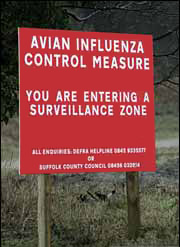 |
| Homepage | The Virus | How it spreads | Symptoms | Complications | Prevention | Treatment | FAQ |
| What is Avian Influenza (Bird Flu)? | |||
|
| Why are we so concerned about bird flu? |
| Bird flu viruses do not usually infect humans, but several cases of human infection with bird flu viruses have occurred since 1997. The bird flu virus can occasionally jump between species and infect people who have been in close contact with infected birds. Most people who catch bird flu become very ill or die. As of 28th January 2005, 55 people in Asia have been infected with bird flu and 42 of these people have died. In conclusion we ca say that the risk from bird flu is generally low to most people. However, it's important to be aware that during an outbreak of bird flu among poultry (domesticated chicken, ducks, turkeys), there is a possible risk to people who have contact with infected birds or surfaces that have been contaminated with excretions from infected birds. |
| How is bird flu virus passed from birds to people? | ||
|
| How are bird flu viruses different from human flu viruses? |
| There are many different subtypes of type A flu viruses. These subtypes differ because of certain proteins on the surface of the flu A virus (hemagglutinin [HA] and neuraminidase [NA] proteins). There are 16 different HA subtypes and 9 different NA subtypes of flu A viruses. Many different combinations of HA and NA proteins are possible. Each combination is a different subtype. All subtypes of flu A viruses can be found in birds. However, when we talk about “bird flu” viruses, we are referring to those flu A subtypes that continue to occur mainly in birds. They do not usually infect humans, even though we know they can do so. When we talk about “human flu viruses” we are referring to those subtypes that occur widely in humans. There are only three known subtypes of human flu viruses (H1N1, H1N2, and H3N2); it is likely that some genetic parts of current human flu A viruses came from birds originally. Flu A viruses are constantly changing, and they might adapt over time to infect and spread among humans. |
| What are the symptoms of bird flu in humans? |
| Symptoms of bird flu in humans have ranged from typical flu-like symptoms (fever, cough, sore throat and muscle aches) to eye infections, pneumonia, severe respiratory diseases (such as acute respiratory distress), and other severe and life-threatening complications. The symptoms of bird flu may depend on which virus caused the infection. |
| How does bird flu spread? |
| Infected birds shed flu virus in their saliva, nasal secretions, and feces. Susceptible birds become infected when they have contact with contaminated excretions or surfaces that are contaminated with excretions. It is believed that most cases of bird flu infection in humans have resulted from contact with infected poultry or contaminated surfaces. |
 |
Terms of Use |

